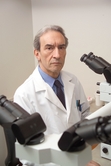The management of unicentric and multicentric Castleman's disease: A report of 16 cases and a review of the literature Journal Article
| Authors: | Bowne, W. B.; Lewis, J. J.; Filippa, D. A.; Niesvizky, R.; Brooks, A. D.; Burt, M. E.; Brennan, M. F. |
| Article Title: | The management of unicentric and multicentric Castleman's disease: A report of 16 cases and a review of the literature |
| Abstract: | BACKGROUND. Castleman's disease (CD), or angiofollicular lymph node hyperplasia, creates both diagnostic and therapeutic dilemmas for most physicians. For patients with this rare and poorly understood disease, the optimal therapy is unknown. The authors report their experience during the years 1986-1997 with this uncommon clinicopathologic entity. METHODS. Sixteen patients with a histologic diagnosis of CD were identified in the pathology database. Unicentric disease was defined as a solitary mass. Multicentric disease compromised patients with widespread lymphadenectomy. Clinical, radiologic, and laboratory data were analyzed to evaluate treatment response; RESULTS. The study group consisted of 16 patients classified into 3 clinicopathologic groups: hyaline-Vascular, plasma cell, and 'mixed.' Of those patients who underwent complete surgical excision of a unicentric hyaline-vascular CD mass (n = 8), all remain symptom free without clinical or radiographic recurrence. Two patients remain asymptomatic following partial resection or radiation therapy for an unresectable unicentric hyaline- vascular CD mass. Two patients with multicentric hyaline-vascular CD are currently in complete remission following adjuvant therapy. Multicentric plasma cell CD was present in a single patient. This patient (who underwent surgical and systemic therapy) died of disease within 4 months of presentation. Three patients with unicentric hyaline-vascular/plasma cell-CD remain symptom free following either complete resection or observation. CONCLUSIONS. The authors recommend surgical resection for patients with the unicentric variant of CD. Surgical removal of a unicentric mass of hyaline- vascular or hyaline-vascular/plasma cell type is curative. Partial resection, radiotherapy, or observation alone may avoid the need for excessively aggressive therapy. Patients with multicentric disease, either hyaline- vascular or plasma cell type, do not benefit from surgical management and should be candidates for multimodality therapy, the nature of which has yet to be defined. |
| Keywords: | adult; clinical article; treatment outcome; middle aged; cancer surgery; multimodality cancer therapy; cancer radiotherapy; tomography, x-ray computed; cancer classification; management; castleman's disease; angiofollicular lymph node hyperplasia; giant lymph node hyperplasia; humans; human; male; female; priority journal; article |
| Journal Title: | Cancer |
| Volume: | 85 |
| Issue: | 3 |
| ISSN: | 0008-543X |
| Publisher: | Wiley Blackwell |
| Date Published: | 1999-02-01 |
| Start Page: | 706 |
| End Page: | 717 |
| Language: | English |
| DOI: | 10.1002/(sici)1097-0142(19990201)85:3<706::aid-cncr21>3.0.co;2-7 |
| PUBMED: | 10091744 |
| PROVIDER: | scopus |
| DOI/URL: | |
| Notes: | Article -- Presented in part at the 50th Annual Cancer Symposium of the Society of Surgical Oncology that took place on March 21, 1997 in Chicago, IL -- Export Date: 16 August 2016 -- Source: Scopus |
Altmetric
Citation Impact
BMJ Impact Analytics
Related MSK Work






